Structure to Function
Clarification Statement: Examples of structures could include thorns, stems, roots, colored petals, heart, stomach, lung, brain, and skin.
Assessment Boundary: Assessment is limited to macroscopic structures within plant and animal systems.
Structure and Function
A central feature of life is that organisms grow, reproduce, and die. Organisms have unique characteristic structures, functions, and behaviors. Coral reefs are ecosystems that provide examples of specific structures, or body designs, that serve designated functions. The reef structure creates numerous and varying habitats that allow a variety of organisms to exist and fulfill roles, or niches, in the reef community. Fish and other animals in the reef habitat have evolved various feeding methods and body structures that allow them to survive and thrive in reef environments.
Reef Fish Feeding
Fig. 1. Reef ecosystems provide complex structures for fish to live in, around, or atop. Specialized feeding strategies help each fish survive in this competetive environment.
Image courtesy of Andrew Gray/NOAA, Flikr
There are many sizes, shapes, and colors of reef fishes living in coral reef habitats (Fig. 1). Fishes have a variety of methods and adaptations for feeding, depending on the area of the reef they inhabit and the composition of their diet. Reef fishes live in areas above the reef, on the surface of the reef, in reef crevices and caves, and on the sandy bottom near the reef. Reef fishes often have special mouth features to help them feed—which they use to feed in specific style and eat a particular type of food.
Herbivores feed on marine plants called algae. Algae usually grow on the surface of the reef; some fishes even farm their own algae beds. Herbivores have mouth forms and teeth designed to scrape the algae off of rocks and coral. Reef fish that eat zooplankton, invertebrates, and other fish are called carnivores. Carnivores have unique mouth forms and teeth, depending on the type of animal they eat (Fig. 2).
Fig. 2. The long teeth of the barracuda help this carnivore eat.
Image courtesy of Wikimedia
Some carnivores have small mouths useful for plucking zooplankton from the water column. Other carnivores have large mouths that help engulf their prey, allowing the fish to swallow its prey whole. Many carnivores have unique mouth features that help them feed in a particular area of the reef, or on a particular type of prey. For example, the longnose butterflyfish has a very long snout that helps it probe into deep crevices to find worms and other invertebrates (Fig. 3); the goatfish has structures hanging from its lower jaw (barbels) that help it dig in the sand to find invertebrates.
Reef fish that are omnivores eat both algae and animals. Omnivorous fish do not have as specialized a diet as fishes that are strictly herbivores or carnivores. Omnivores are sometimes called generalists.
Feeding Structures
Some of the unique modifications in mouth shapes and body features found in common Hawaiian reef fishes are described below:
Butterflyfishes (Chaetodontidae):
Fig. 3. The long nose of this butterfly fish allows it to crab food in small crevices.
Image courtesy of Wikimedia
These brightly colored reef fish have very short, small mouths that allow them to graze on algae growing on the reef. butterfly fishes also eat small invertebrates like coral polyps and anemones. Butterfly fishes are considered omnivores. However, some butterfly fish have very specialized, long snouts they use to reach into the coral and eat coral polyps (e.g., Longnose butterfly fish, lauwiliwilinukunukuoi‘oi) (Fig. 3).
Damselfishes (Pomacentridae):
Fig. 4. Damselfish have a slightly upturned and large mouth compared to their body size to slurp in plankton from the water.
Image courtesy of Wikimedia
Damselfish are often found in small groups hovering right above the reef in search of tiny animals and plants floating in the plankton. They have short snouts but relatively big mouths that allow them to suck the plankton out of the water column (e.g., sergeant major fish, mamo, Fig. 4). Many damselfishes are also gardners of algae; the fish weed out algae they dislike and protect the algae they prefer to eat.
Moray Eels (Muraenidae); puhi:
Fig. 5. Eels have rows of teeth to help them grab and hang on to speedy fish that swim by.
Image courtesy of Betty Wills, Wikimedia Commons
Eels are carnivorous ambush predators that wait in cracks and crevices in the reef to capture passing prey. Eels possess big sharp teeth and have large mouths (Fig. 5).
Goatfishes (Mullidae); weke‘ā:
Fig. 6. A school of goatfish swim along the reefs in Niʻihau. When they feed, they scrounge the bottom sediment using the barbels on the bottom of their mouths.
Image courtesy of Andrew Grey/NOAA Fisheries
Goatfishes have mouths on the bottom of their snouts. Goatfishes also have two barbels, or feelers, for tasting and searching the sandy bottom for worms and other soft-bodied invertebrates that live in the sand (Fig. 6).
Parrotfishes (Scaridae); uhu:
Fig. 7. This parrotfish from the North Western Hawaiian Islands has teeth-like structures that allow it to scrape algae off the substrate.
Image courtesy of NOAA, Wikimedia Commons
Parrotfishes have large teeth that are fused together and strong jaws to enable them to scrape algae and coral from the reef. Parrotfishes are primarily herbivores (Fig 7).
Absurd Creature of the Week: This Goofy Fish Poops out White-Sand Beaches by Matt Simon
Body Structures for Defense
Life on a reef can be dangerous for many organisms—because there is always the chance that a predator may be lurking. The evolution of defense structures has resulted in many unique features that help reef organisms survive. Examples of defense structures in common Hawaiian reef fishes, and associated reef organisms, follow:
Fig. 8. A whitespotted surgeonfish (at Hanauma Bay) has a hidden spine at the base of the body.
Image courtesy of Steve Ryan, Wikimedia Commons
Surgeonfishes are named for the knifelike spines, or scalpels, on either side of the base of their tails. One swipe of the tail can slash an enemy or intruder (Fig. 8).
Fig. 9a. An x-ray image of a longnose butterfly fish show off the hidden spines.
Image courtesy of Wikimedia Commons
Fig. 9b. The false eye spot on this butterflyfish might confuse a predator.
Image courtesy of Wikimedia Commons
Butterflyfishes have many spines disguised in their fins. They use very vivid coloration to announce their potential danger to a predator or enemy (Fig. 9a). Many different types of butterflyfishes, like the millet seed butterfly fish (lauwiliwili), also have big false eye spots near their tails to confuse predators concerning their actual size (Fig. 9b).
Fig. 10. This porcupine fish is displaying itʻs defenses after being accidentally caught.
Image courtesy of NOAA
Porcupine pufferfishes not only inflate their bodies with water to avoid being eaten, but they also have large spikes that poke out from their bodies to prevent capture (Fig. 10).
Fig. 11. This scorpionfish is a master of disguise.
Image courtesy of Taylor Williams/NOAA Fisheries
Scorpionfishes use coloration to blend into their habitat, effectively hiding themselves by looking like a part of the reef. Because these fish are ambush predators, they also use this advantage to capture unknowing prey. Scorpionfishes also have poisonous spines in their fins (Fig. 11).
Fig. 12. Nudibranchs are often brightly colored and elaborate organisms.
Image courtesy of Wikimedia Commons
Sea snails and nudibranchs use bright coloration patterns to warn potential predators that they may taste bad or are poisonous (Fig. 12).
Fig. 13. This coral polyp found in Hawaii has hidden stinging cells used for defense and food capture.
Image courtesy of Narissa Spies, Wikimedia Commons
Corals also have specialized defense mechanisms called nematocysts. Nematocysts are stinging cells that are released when the coral is harassed by predators. Since corals cannot move or shake off any sediment or other particles that may fall on them, they also continually shed mucous to slough off anything that might try to settle on them (Fig. 13).
Fig. 14. This crab uses anemones stuck to its shell as added defense.
Image courtesy of Nick Hobgood, Wikimedia Commons
Crabs have large claws that they use to defend themselves against predators. Crabs also use their claws to catch food. Certain types of hermit crabs often keep anemones on their shells for protection (Fig. 14).
Fig. 15. This anemone resembles a coral polyp and has the same defensive stinging cells called nematocysts.
Image courtesy of NOAA
Anemones have special stinging cells in their tentacles, just like corals. When a predator tries to eat the hermit crab, it gets a mouthful of nematocysts instead.



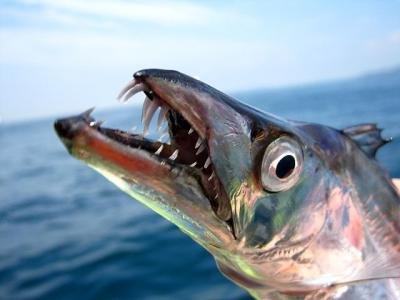
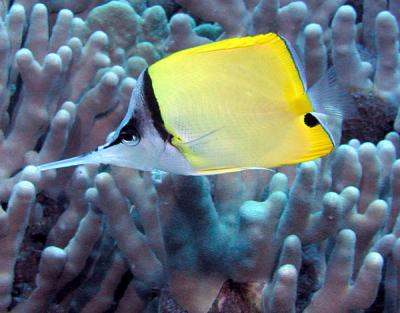

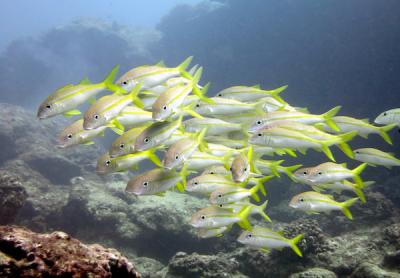

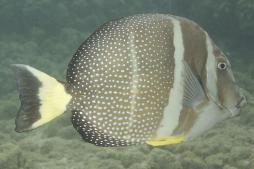

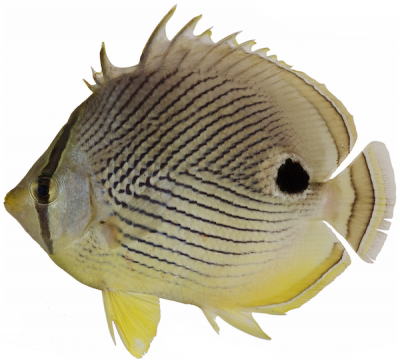
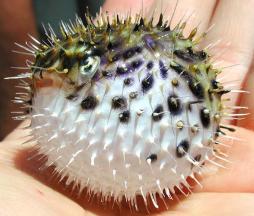
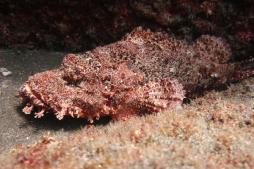
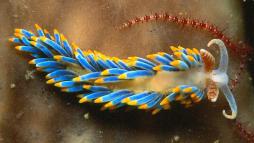

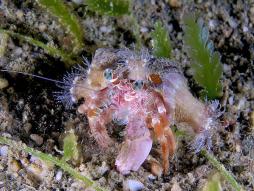
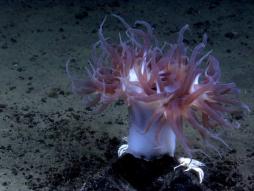









NY Times article about Damselfish algae gardens